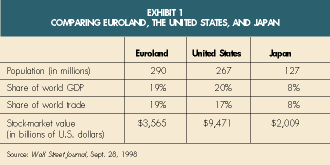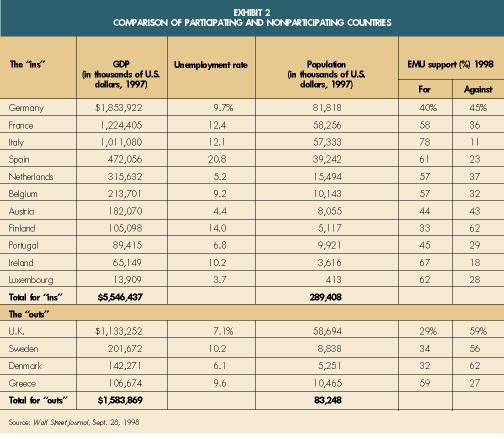April 1999 Issue
International Perspectives
Background on the Euro
By Marc Levine, Francis Kim, and Joel Siegel
The euro is the name of the European Union's new single currency, which came into existence on January 1, 1999, when the exchange rates among the currencies of the 11 participating nations were irrevocably fixed both against each other and against the euro itself. The euro is the European currency unit (ECU) renamed. The ECU is the unit of currency used by the European Community (EC), the political and
economic predecessor organization to the European Union (EU). Although superseded to some extent by the EU,
the EC continues to exist as a political body today.
The ECU is actually a currency composite determined by the economic size of each participating EC member. An ECU is exchangeable one for one for a euro, but their use and distribution are different. The ECU, for example, was not held or used by individuals but served as an accounting unit, reserve unit, and unit of settlement for the European Monetary System (EMS) central banks. Although the euro currently functions similarly, it will be circulated to the general public in the form of notes and coins beginning
January 1, 2002.
The euro federation presently consists of 11 EU countries: Austria, Belgium, Finland, France, Germany, Ireland, Italy, Luxembourg, the Netherlands, Portugal, and Spain. Denmark, Sweden, and the United Kingdom decided not to join initially, but may choose to do so in the future. Greece failed to meet the economic conditions for participation but is working to qualify at a later date. In addition, the EU is actively wooing other countries in order to expand the euro federation into central and eastern Europe.
The Roots of the Euro
The creation of the euro and the EU can be traced back to the establishment of the EC. The EC represented the consolidation of three European communities in 1967: the European Coal and Steel Community, the European Economic Market (or Common Market), and the European Atomic Energy Community. In 1979, the European Economic Market created the EMS to stimulate European fiscal integration, minimize trade interferences resulting from fluctuations due to currency exchange rates, and, most importantly, support European monetary stability. The EMS requires that its members deposit gold and dollar reserves with the European Monetary Cooperation Fund in exchange for the issuance of ECU currency. All EC countries except Greece participate in the EMS exchange rate system.
The drive toward European unification actually began after World War II, when European sentiment favored a Germany and France that would be economically interdependent, so that they would never declare war on each other again. European exchange rate agreements evolved from early trade agreements, and from these emerged broader economic agreements. The creation of the EC in 1967 was the culmination of these accords. The emphases of the EC were both political and economic. It aimed to break down trade barriers within a common market and create a political union among the people of Europe. The Maastricht Treaty, which became effective November 1993, set out stages of transition to an even more integrated monetary union among the EC participating countries. This association is commonly referred to as the European Monetary Union (EMU). Some of the integrating stipulations of the Maastricht Treaty were--
introduction of a single currency, the ECU or euro,
creation of a European system of
central banks,
establishment of a European Central Bank (ECB), and
stimulation of cohesive European unity by creating cooperative efforts relating to justice and home affairs and establishing common foreign and security policies.
The treaty specifically envisioned three stages of transition from the EC to the EMU. The first stage concluded with the ratification of treaty amendments needed to establish the EMU and required that all 12 member states participate in the European exchange rate program. The program set limits on the amount by which exchange rates could vary with respect to any two currencies. In addition, the treaty involved the elimination of all restrictions on the movement of capital between the member states and between member states and third countries. (This goal was not achieved.)
The second stage began January 1, 1994, with the creation of the European Monetary Institute (EMI) to support the development of the ECU and the establishment of the ECB. It was hoped that an ECB would, eventually, perform such functions as--
implementing a common European monetary policy,
conducting foreign exchange
operations,
promoting smooth EU payment mechanisms, and
holding the reserves of EU member countries.
The EMI acted as a precursor to the ECB until 1999. During this period, it oversaw the operation of the European Monetary System, held the gold and foreign exchange reserves of the EU members, and advocated the use of the ECU and its clearinghouse. In addition, it monitored the economic pulse of the member countries of the EU to ensure they would be capable of joining the EMU in 1999. To qualify to join the EMU, countries had to meet the following criteria by the end of 1997:
Inflation. A consumer price index rate of inflation of not more than 1.5% around the three member countries with the lowest inflation rates.
Currency Maintenance. A currency exchange relationship within agreed-upon margins around its fixed value in terms of the ECU with no devaluation against any other member country for
two years.
Long-term Interest Rates. Long-term interest rates (10-year government bond rates) of not more than two percent above the three member countries with the lowest rates of inflation.
Government Deficit. No excessive government deficit. A government deficit is not considered excessive if it does not exceed three percent of its yearly gross national product. In addition, the value of outstanding government debt should not exceed 60% of its yearly gross domestic product.
The third and final stage of the Maastricht Treaty commenced January 1, 1999, with the establishment of the euro as the official currency of the EMU.
 The Euro vs. the Dollar
The Euro vs. the Dollar
Although it is obvious that the creation of the euro will have a significant effect throughout Europe, it is also fair to speculate that it will have a notable impact on the global financial system. There are many advantages that accrue to the dominant international currency. This lofty position has been held by the U.S. dollar since World War II. This status, for example, results in cheaper financing and business transaction costs, reduced interest rates on government debt, advantageous competitive positions for financial institutions and banks, strengthened international political power, and stimulation of domestic economic growth. The United States pays less interest on its bonds because of the high demand for dollars and dollar-dominated securities. Because of this demand, the United States is also able to use its own currency to finance its balance-of-payments deficit. This reduces the effect of the United States' trade imbalance. In addition, U.S. companies, dealing in international trade, have a degree of protection from currency fluctuations because of their ability to invoice exports of goods in dollars.
Because of the positive world attitude regarding the safety of the dollar--evidenced by the large holdings of dollars by foreign central banks and the foreign private sector--the U.S. dollar will always enjoy a dominant currency position. However, the euro will undoubtedly contend as a major world currency. The euro will likely become the world's second largest currency behind the dollar and may even compete against it as the premier international currency on the basis of the combined size of euro economies. Recent estimates indicate that euro countries represent approximately one-quarter of the world's economy. In addition, these nations will account for approximately 40% of total global trade (including trade within the euro countries), making it the world's largest trading federation. A myriad of countries around the world are major trading partners to the euro-bloc countries and may adopt the euro instead of the dollar as their major trade currency. If the United Kingdom was to join the EMU, it would only add to the relative importance of the euro worldwide.
If there is a shift away from the dollar, many predict other adverse effects for the United States. For example, reducing the domination of the dollar as the leading international currency, it is believed, would undoubtedly reduce U.S. influence worldwide. A switch to the euro would magnify America's "greatest debtor" global status. The United States would then have to compete with other countries for euro funds that would offer "safe haven status" for worldwide investments. This, in turn, would have an adverse effect on the dollareuro exchange rate, increasing the price of U.S. imports.
The Euro Will Have an Impact
Although predicting the demise of the dollar as the world's leading currency may be premature, the growth of the euro as a leading international currency is inevitable. As other nations join the EMU in the year 2002, the euro's influence will spread. It is likely that foreign nations that frequently trade with Europe will choose the new currency. Multiplying this development will be the effect of many central banks of the world switching their dollars to euros, and the ECB's active promotion of the single currency. *
Marc Levine, PhD, CPA, Francis Kim, PhD, and Joel Siegel, PhD, CPA, are professors at Queens College of the City College of New York.
Editor:
James L. Craig, Jr., CPA
The CPA Journal

The CPA Journal is broadly
recognized as an outstanding, technical-refereed publication aimed at public
practitioners, management, educators, and other accounting professionals.
It is edited by CPAs for CPAs. Our goal is to provide CPAs and other accounting
professionals with the information and news to enable them to be successful
accountants, managers, and executives in today's practice environments.
©2009
The New York State Society of CPAs. Legal
Notices
The Euro vs. the Dollar
